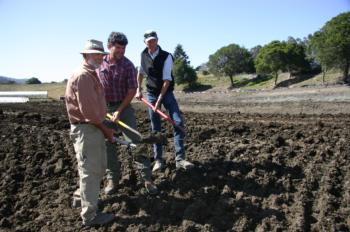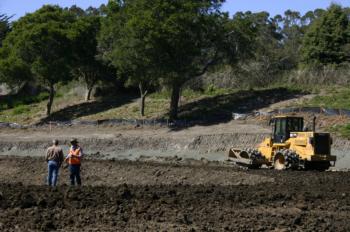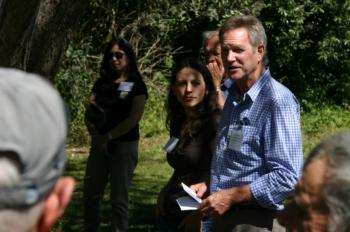Crossing to Water Security for Fish and Farms
By David Lewis, UCCE Marin County Director and Watershed Management Advisor
What are the sounds of a summer stream and vegetable farms? At the moment in Pine Gulch Creek one hears the roar, beeps, and whistles of heavy equipment moving earth. This is because a novel and model project for managing water is being installed on three West Marin farms.

Farmers Dennis Dierks, Peter Martinelli, and Warren Weber with shovels in hand to commemorate the Pine Gulch Project ground breaking
Pine Gulch Creek is a 17-square mile watershed due north of the town of Bolinas. It epitomizes California’s coastal streams with a mix of private agricultural and publically managed lands. The landscape is open and rural, yet in close proximity to the highly populated urban setting of the greater San Francisco Bay area. Farming in the watershed dates back to at least the late 1800s, when agricultural products were loaded on ships in Bolinas Lagoon and shipped to San Francisco. Steelhead trout and to a lesser degree coho salmon were prominent in the watershed and since the 1970s, have suffered similar population declines, as the entire Central California Coast unit.
The availability of water for farming and in-stream flow for fish is driven by the quantity and timing of annual rainfall and its capture and management. “We have an all or nothing climate, ” explained Peter, “and the project answers that challenge with a stream that has intact summer flows and the ability to capture water for farming.” The project that broke ground on the farms of Warren Weber, Dennis and Sandy Dierks, and Peter Martinelli is designed with these rainfall amounts and timing in mind. The project will store winter water during large storms replacing what has been the usual practice of summer time diversions.

Project engineers and equipment operators dig one of the project ponds that will store winter water for summer time crop use
Five ponds are currently being built that will store a combined 52.6 acre-feet of water, enough to farm what is currently in production. “If this works it gives the farm water security” shared Warren. Dennis added “Knowing that there is water stored going into rainfall uncertainty and not having to go in the creek habitat in the summer gives us security.” “I can’t wait to do the first irrigation out of the pond,” said Peter, adding “Current summer in-stream use is a complex coordinated schedule. The water banked by the project gives me the flexibility and independence to water crops that I don’t currently have.”
Signing onto this project was a natural fit for these three farmers. Peter grew up in the watershed, experienced the steelhead decline and has a “deep appreciation for the natural resource in the creek.” Warren is a local and national leader in organic farming and has the philosophy that “the farm is about finding a balance between natural and agriculture resources with water use as one element of that balance.” Dennis and Sandy, as part of the Paradise Valley community that began in the 1970s, were and continue to be “concerned about the quality of food and food for their families and how to provide that food so it’s not a detriment to the environment.”

Marin County Supervisor Steve Kinsey, Elise Suronen & Bob Giacomini of Marin Resource Conservation District, Gayle Seymour of Dept of Fish & Wildlife
Success going forward equates to successfully filling the ponds each rainy season and having adequate stream flows that support fish. Warren, describing the spirit of the project, explained “this is everyone’s project, so if the ponds can’t get filled then we have a bridge to nowhere. We know the water resource is there, it is a timing issue. If successful, the stream is healthier than it was for the fish and the farm continues to produce the food that people need.” Peter conveyed a longer term and more broad measure of success with the hope that “the project is applied in other watersheds, harvesting rainfall onsite when it is abundant to benefit the environment.”
This coming winter will be the first test for the project. As the rains move in and the stream flow rises, the ponds will be filled. In the subsequent summer, the stream flow will be unimpeded by diversions for irrigation. This point in time, with the project ponds nearing operation, represents the evolution and accomplishment of a large group of organizations and individuals. The project was a learn-by-doing exercise and laboratory in watershed hydrology, water rights policy, and multi-agency coordination. This is what happens when doing something that has not been done before; it requires patience, respect, and perseverance. Dennis relayed the appreciation felt by all the farmers when he said, “I want to thank all the agency representatives and all the folks that stuck with this and got it to happen.”
(The article title makes reference to Charles Wilkinson’s book Crossing the Next Meridian about land and water use policy in the western United States.)



